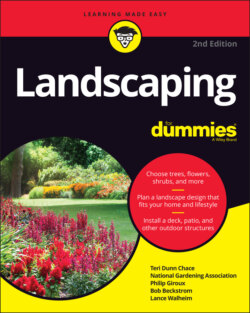Читать книгу Landscaping For Dummies - Lance Walheim - Страница 101
Installing a retaining wall
ОглавлениеTo orient you to this project, the following steps generally apply to installing retaining walls of any kind:
1 Clean up the designated area by removing plants, grass, and any loose debris.
2 To create a base, start at the bottom of the hill or slope and dig a trench with a shovel.Dig an inch (2.5 cm) for every 8 inches (20.3 cm) of wall height. For example, if your wall will be 3 feet, or 36 inches, tall, do the math: 36 inches divided by 8 inches = dig 4½ inches deep (or, in metric: dig 11.4 cm deep).The length and width depends on the materials you’re using.GETTING ACQUAINTED WITH SOME JARGONHere are definitions for some technical terms and materials that may be unfamiliar to you when dealing with retaining walls.:#1 stone: Replaces “drain rock” of old; basically, it’s compactable gravel.Batter/battered: In this context, it refers to a particular type of angle, for any kind of wall that has been built with an intentional slope.Deadman/deadmen: Horizontal braces.Geotextile fabric: Synthetic material that is permeable. It’s used to aid in drainage, provide erosion control, and increase soil stability. It’s basically better, more expensive landscape fabric.Rebar: Means reinforced bar; it’s a tension device made of galvanized steel, used to reinforce and strengthen structures (such as concrete or masonry).Torx drive screws: These have a six-lobed, star-patterned screw drive. Recommended because they’re more secure than Phillips-head or slot-head screws; the design allows for a higher torque to be exerted without damage to the screw itself or the tool.
3 Tamp down the soil in your 4½-inch (11.4 cm) deep trench.
4 Install something to relieve the pressure of water building up behind your new wall.Provide either weep holes along the base of the wall or a perforated drainpipe behind the wall.
5 Add several inches (cm) of stones (#1 stones are best).If you’re using a perforated drain pipe, surround/bury it. Tamp down the stones. Check that the stone base is level, adding or shifting stones as necessary until it is.
6 Line the bottom and perhaps also the sides with landscape or geotextile fabric.Use plenty of extra extending beyond the boundaries; you can always trim after your timbers or stones are in place, but you can’t extend too-short pieces. Try to use one continuous piece, but if that isn’t possible, use overlapping pieces. (Doing so not only helps hold the soil down, but it will also prevent weeds from encroaching.) Don’t trim it yet; wait until you’re done. You don’t want soil to come through and cause clogs. Use washed stone because unwashed stone is loaded with silt.
7 Begin to install the wall material.When putting in more than one tier, two things are important:Batter them so each succeeding layer leans back into the hill (in other words, it won’t be perpendicular; this slight slant helps your wall counteract gravity).Backfill each tier with gravel as you go to strengthen it and aid drainage.
There’s more than one way to make an effective retaining wall. Other construction materials to consider include timber, concrete blocks, and stacked stones. Here’s some details about each, including how to erect them properly.
